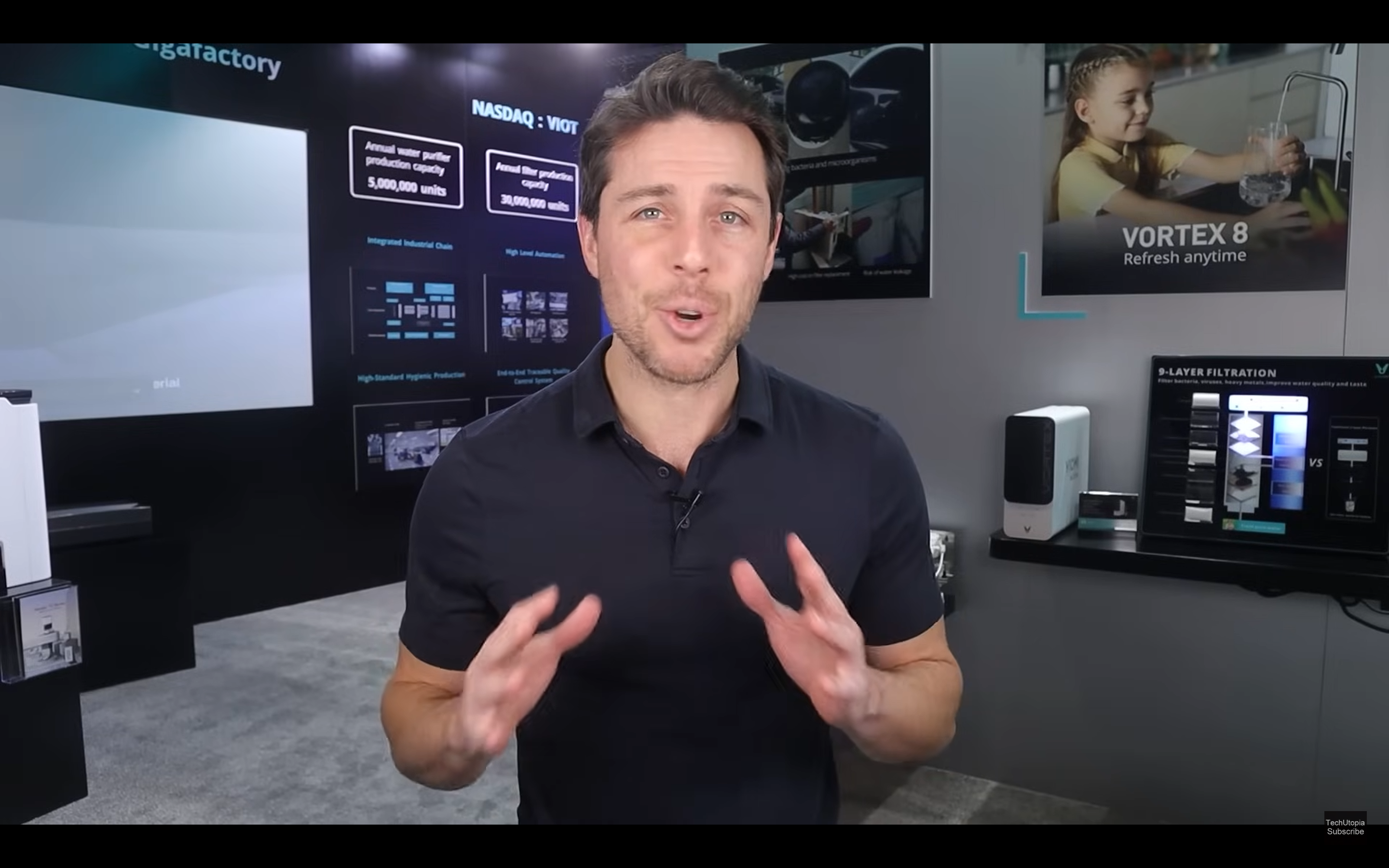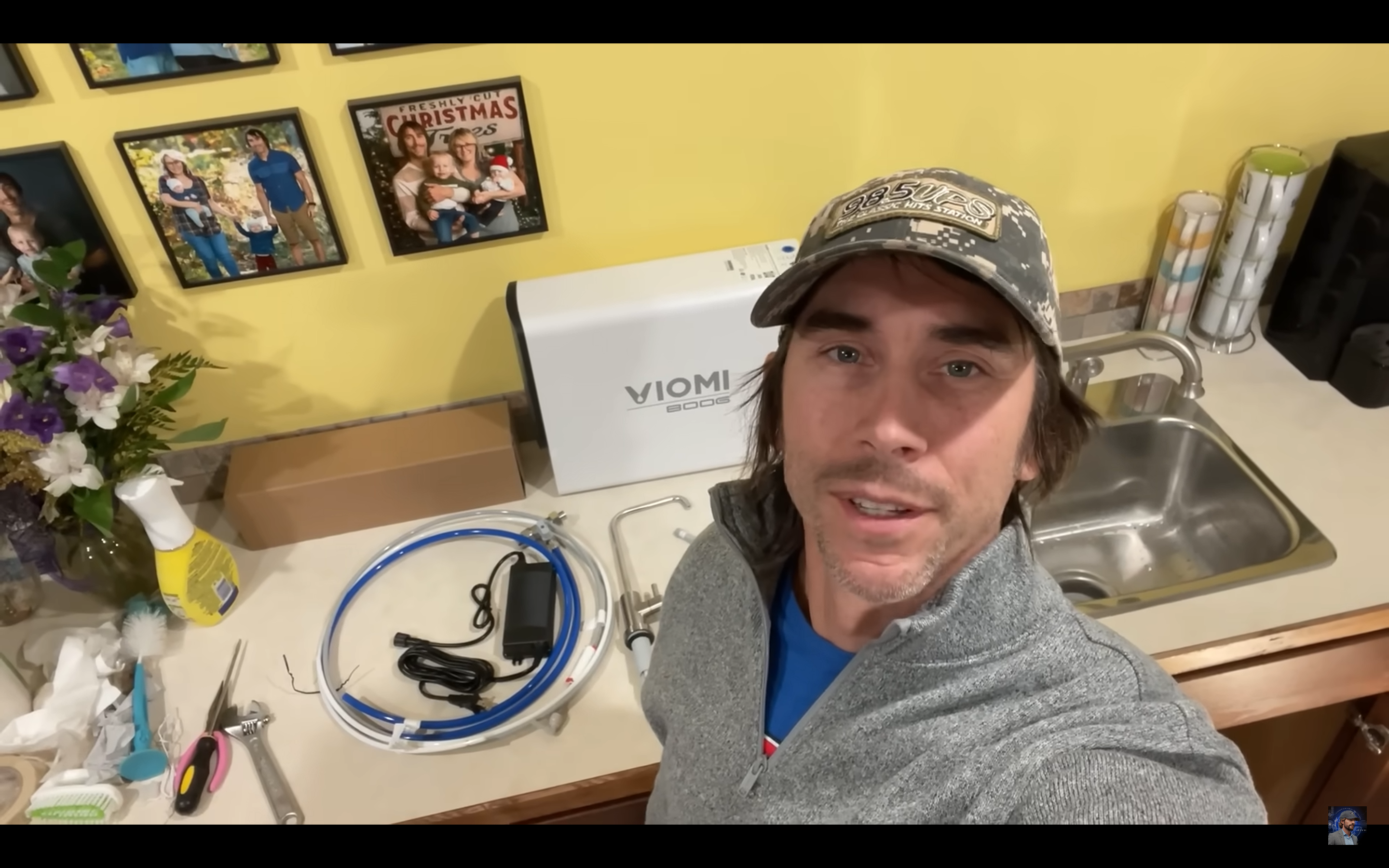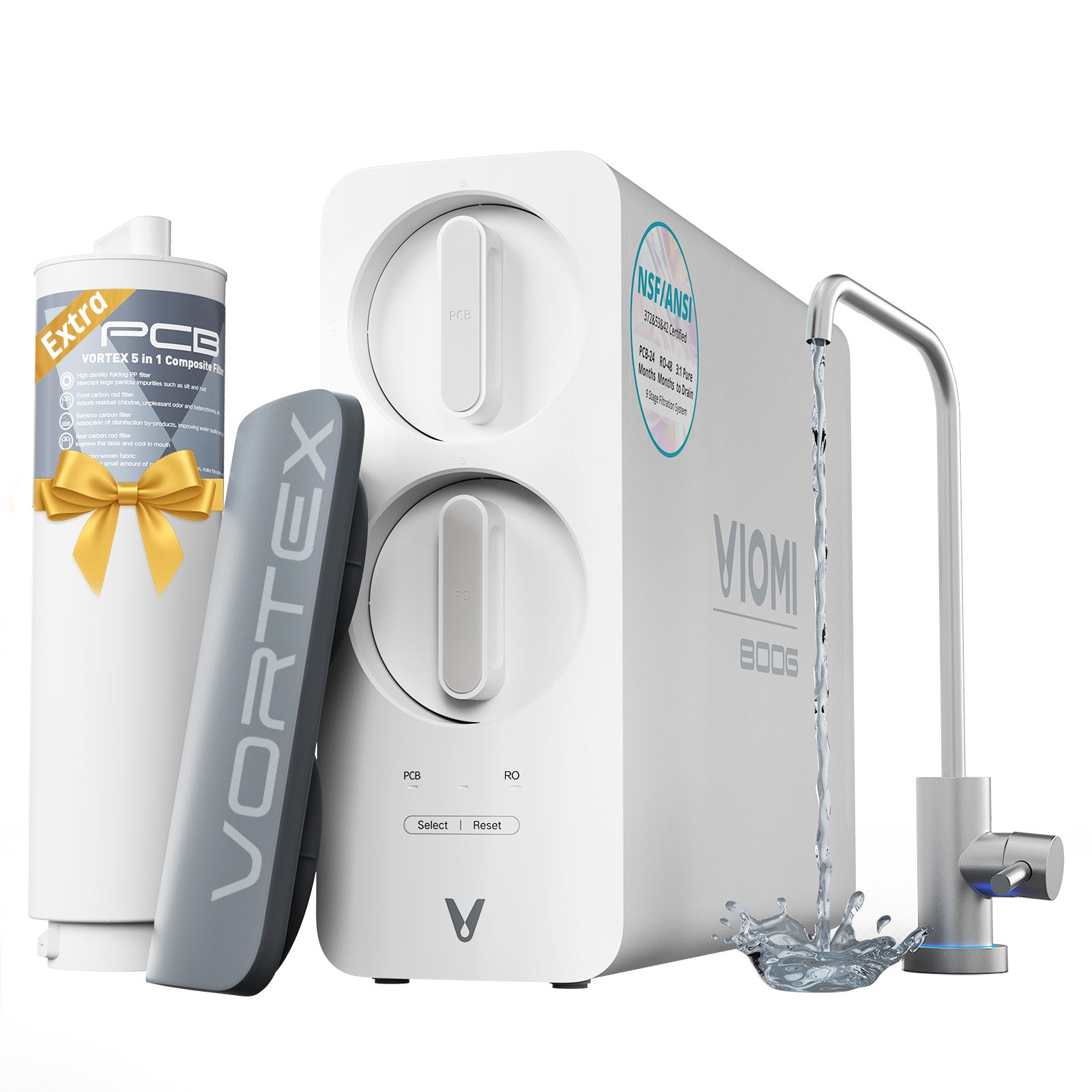


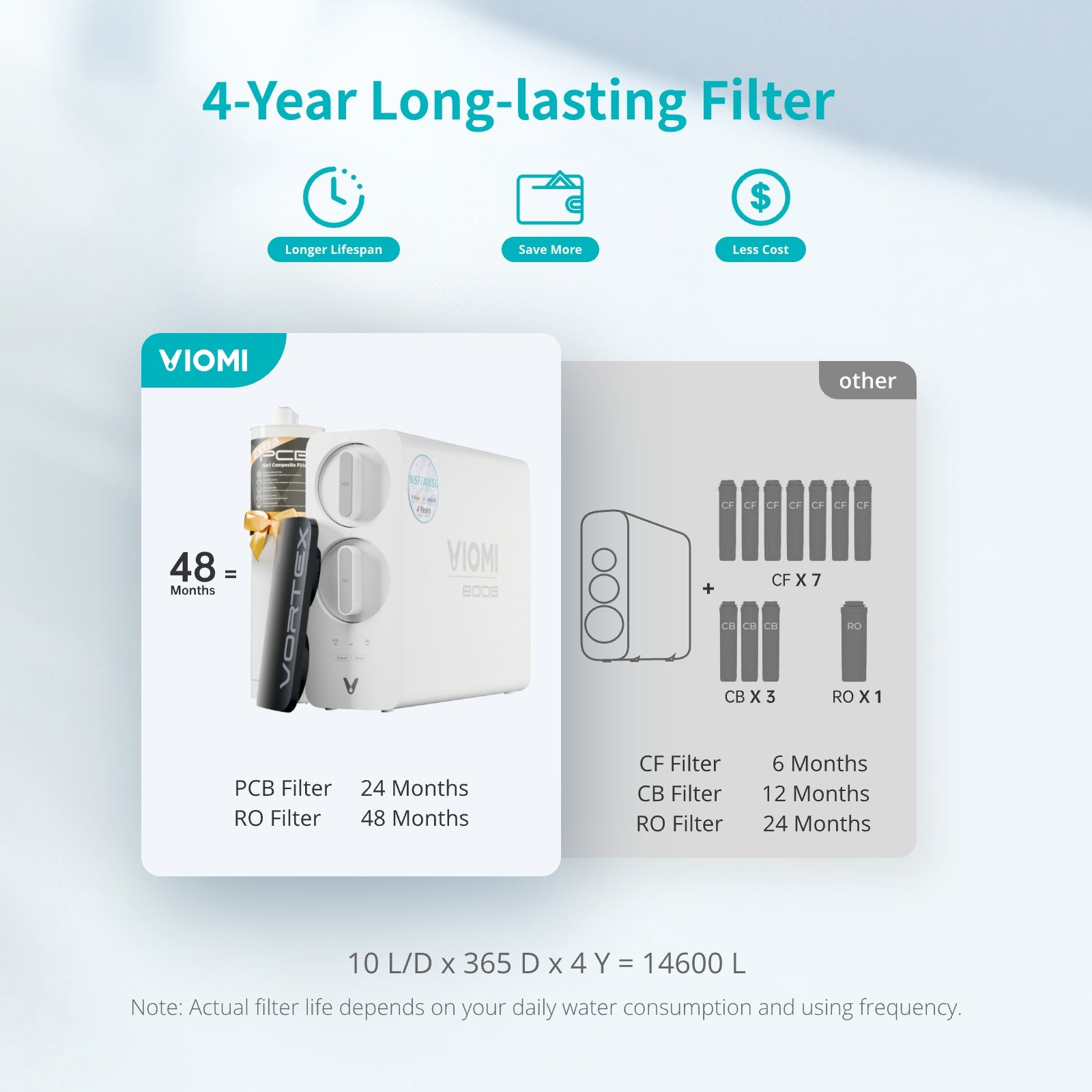


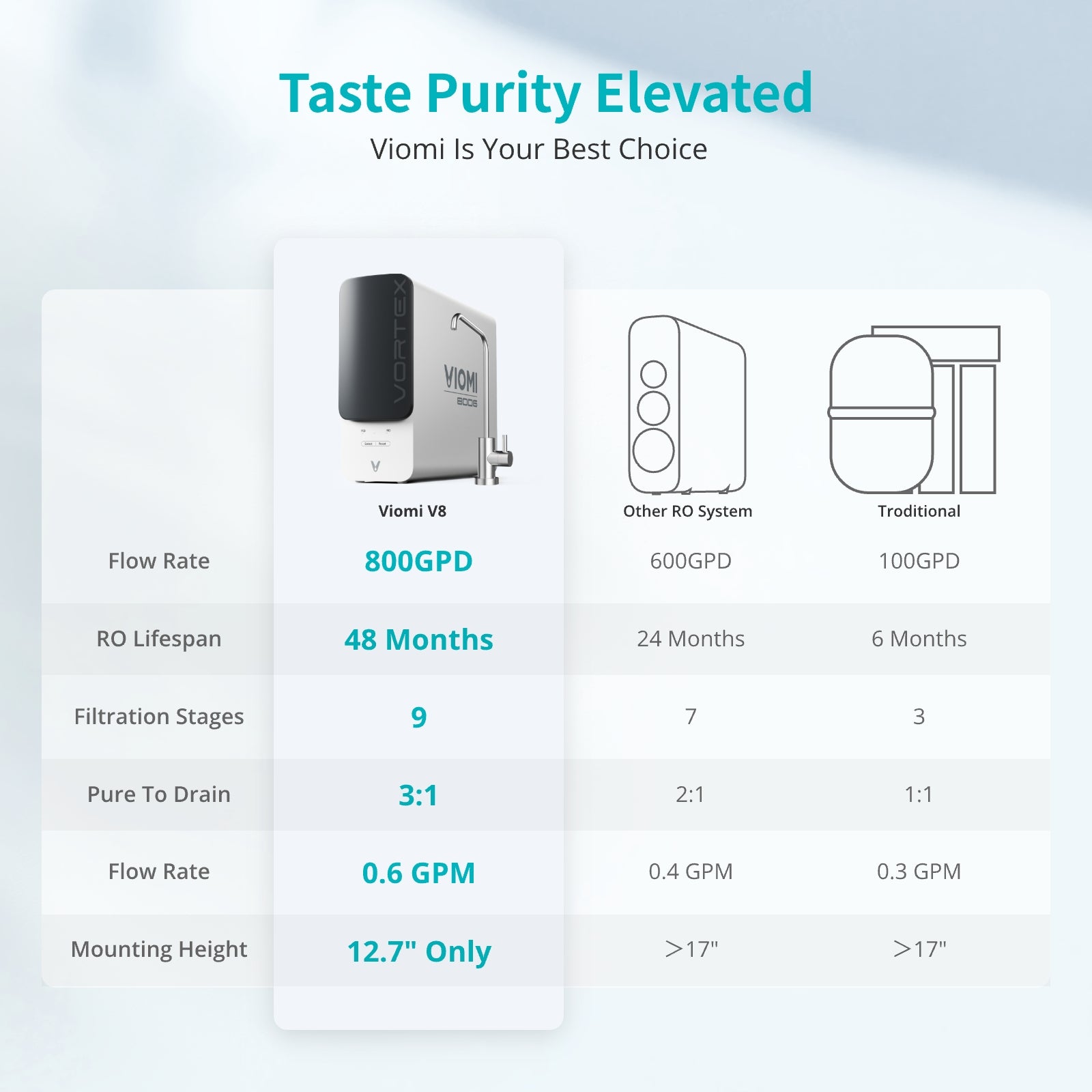
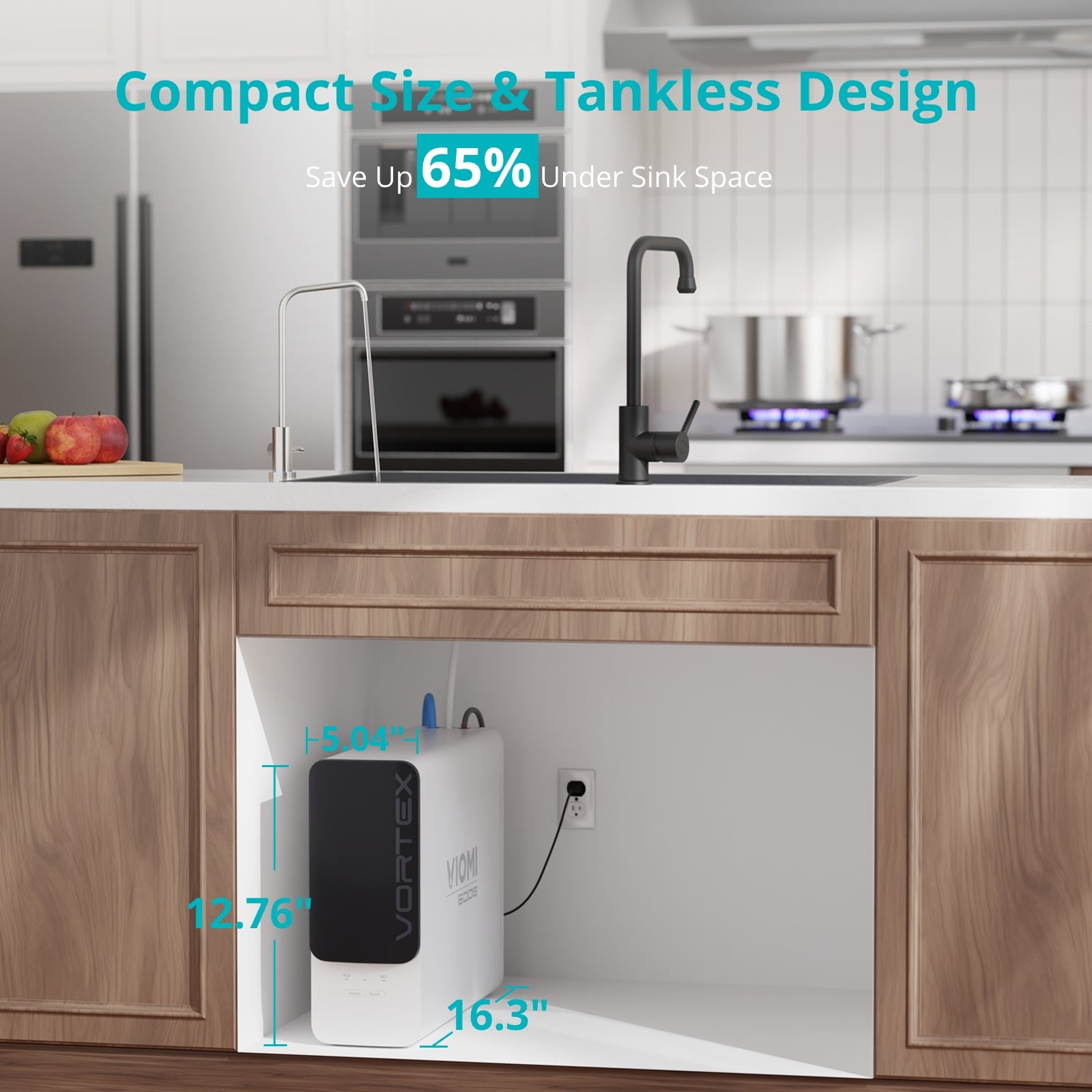
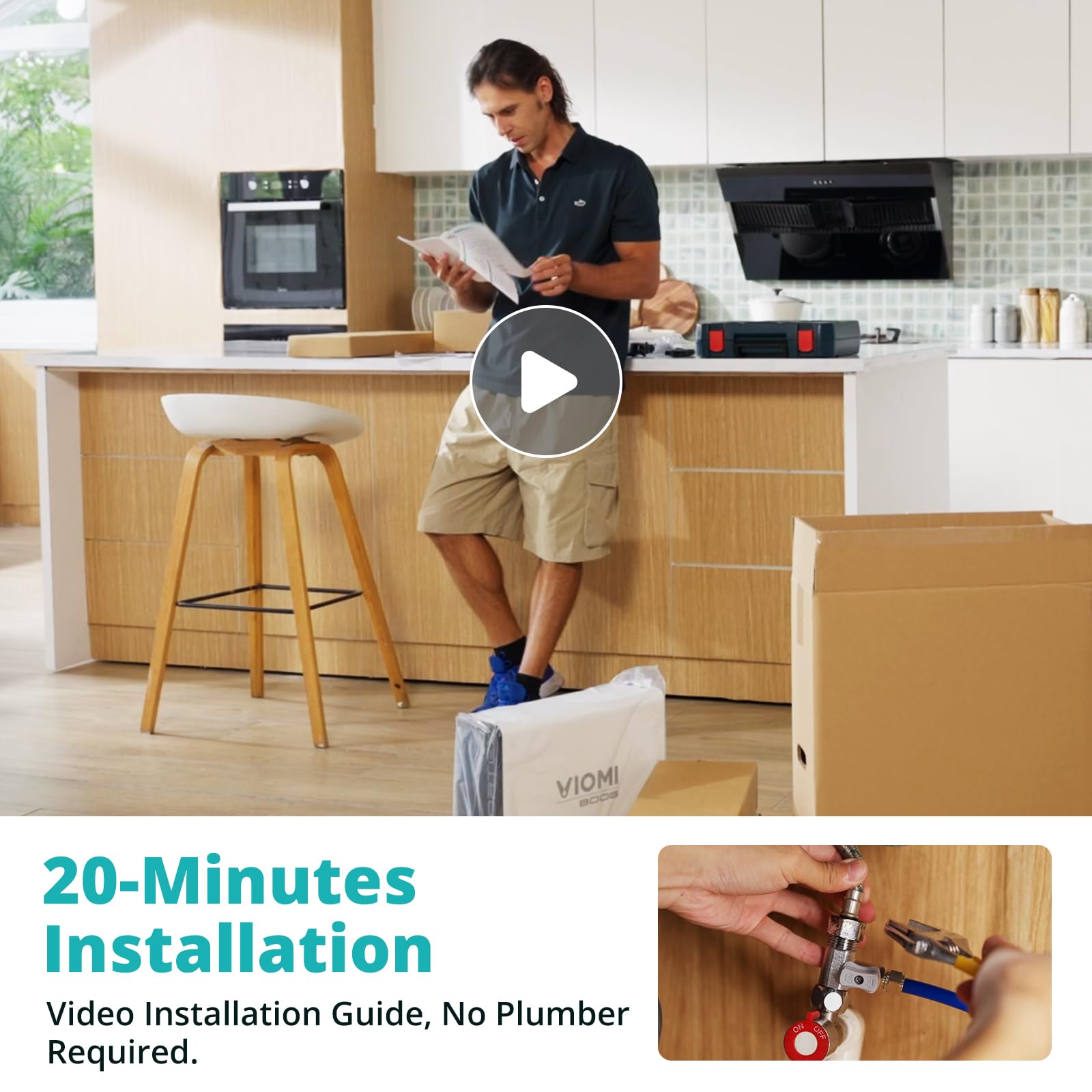
Vortex 8 Tankless Under Sink Reverse Osmosis Water Purifier With Extra PCB Filter
- 【𝐓𝐚𝐧𝐤𝐥𝐞𝐬𝐬 & 𝐂𝐨𝐦𝐩𝐚𝐜𝐭 𝐃𝐞𝐬𝐢𝐠𝐧 𝐍𝐞𝐱𝐭-𝐆𝐞𝐧. 𝐑𝐎 𝐖𝐚𝐭𝐞𝐫 𝐅𝐢𝐥𝐭𝐫𝐚𝐭𝐢𝐨𝐧】Viomi reverse osmosis water filter can not only save 65% of the space under sink but also avoid secondary pollution from the tank. You can quickly install your water purifier within 20 minutes with the help of our 4-step easy installation guide. (Note: Our product size is 16.3"L x 5.04"W x"12.75 H.)
- 【𝟖𝟎𝟎 𝐆𝐏𝐃, 𝐇𝐢𝐠𝐡 𝐂𝐚𝐩𝐚𝐜𝐢𝐭𝐲 & 𝐅𝐚𝐬𝐭 𝐅𝐥𝐨𝐰】6 seconds to fill a 7oz cup of water. You can drink directly without having to wait for the slow filtration of a pitcher filter. A large water flow makes it more convenient to wash fruits and vegetables.
- 【𝐑𝐞𝐝𝐮𝐜𝐞𝐬 𝐓𝐃𝐒 & 𝐏𝐅𝐎𝐀/𝐏𝐅𝐎𝐒 & 𝐌𝐢𝐜𝐫𝐨𝐩𝐥𝐚𝐬𝐭𝐢𝐜𝐬】 Our 9-Stage reverse osmosis Filtration effectively reduces total dissolved solids (TDS), PFOA, PFOS, chlorine, chloramine, lead, heavy metals and other harmful substances in water. With a filtration precision of 0.0001 μm, so you can trust every drop of your drinking water. (Tested by official third-party laboratory (SGS)).
- 【𝟒 𝐘𝐞𝐚𝐫𝐬 𝐋𝐨𝐧𝐠-𝐋𝐚𝐬𝐭𝐢𝐧𝐠 𝐅𝐢𝐥𝐭𝐞𝐫 & 𝐃𝐈𝐘 𝐅𝐢𝐥𝐭𝐞𝐫 𝐑𝐞𝐩𝐥𝐚𝐜𝐞𝐦𝐞𝐧𝐭】 Our reverse osmosis filtration system comes with two filters (one RO filter and one PCB filter. Viomi 800G also offers one additional PCB filter), which makes the total filter lifespan reach up to 4 years. You won't need to specifically remember when to replace the filters since our LED faucet will remind you for filter replacement when the light is orange, and it's so easy for you to replace a filter in seconds without using any tools.
- 【𝐍𝐒𝐅/𝐀𝐍𝐒𝐈 𝟓𝟑 & 𝟑𝟕𝟐 𝐓𝐞𝐬𝐭𝐞𝐝】 The Viomi 800G reverse osmosis system strictly adheres to high water purification standards and has obtained reliable tests and certifications to ensure the health and safety of your drinking water.
- 【𝟑:𝟏 𝐏𝐮𝐫𝐞 𝐓𝐨 𝐃𝐫𝐚𝐢𝐧, 𝐒𝐚𝐯𝐞 𝐌𝐨𝐫𝐞 & 𝐆𝐫𝐞𝐞𝐧 𝐌𝐨𝐫𝐞】 Most tankless RO water filtration system have a purification rate of only 50%, while the V8 achieves an impressive 75%, which can produce only 1 cup of waste water for every 3 cups of pure water produced. With a 3:1 wastewater ratio, it significantly reduces water wastage.
- 【𝐂𝐨𝐦𝐦𝐢𝐭𝐭𝐞𝐝 𝐭𝐨 𝐏𝐮𝐫𝐞 𝐖𝐚𝐭𝐞𝐫, 𝐂𝐨𝐧𝐬𝐢𝐬𝐭𝐞𝐧𝐭 𝐟𝐨𝐫 𝐚 𝐃𝐞𝐜𝐚𝐝𝐞】 Since 2014, Viomi has been dedicated to enhancing and innovating the drinking experience. Over the past ten years, we've served over 100,000 families worldwide, with cumulative sales exceeding 8,000,000 units. We offer 24/7 support, a 30-day money-back guarantee, and a 365-day manufacturer warranty. Let the Viomi 800 GPD be your loyal partner in a healthy lifestyle.
Frequently bought together

If you have any questions, you are always welcome to contact us. We'll get back to you as soon as possible, within 24 hours on weekdays.
-
Shipping Information
Use this text to answer questions in as much detail as possible for your customers.
-
Customer Support
Use this text to answer questions in as much detail as possible for your customers.
-
FAQ’s
Use this text to answer questions in as much detail as possible for your customers.
-
Contact Us
Use this text to answer questions in as much detail as possible for your customers.
- Overview
- Specs
- Reviews
9-Stage RO Complete Filtration
9-Stage RO Complete Filtration
Featured Video Show
FAQs
Please read our FAQs page to find out more.
Q1: What are the benefits of a tankless RO system?
A: The tankless design saves 65% of under-sink space and prevents secondary pollution from a storage tank. Its compact size provides fresh, on-demand filtered water, fitting neatly into your cabinet without taking up valuable space.
Q2: How fast is the water flow about Vortex 8?
A: With an 800 GPD (Gallons Per Day) capacity, the system delivers a very fast flow. It can fill a 7-ounce cup with purified water in just 6 seconds, making it convenient for both drinking and cooking.
Q3: What contaminants does the Vortex 8 remove?
A: The 9-stage filtration system effectively reduces TDS, PFOA/PFOS, microplastics, chlorine, lead, and other heavy metals with a precision of 0.0001μm. Its performance is tested and verified by third-party labs like SGS for trusted purification.
Q4: How often do I need to replace the filters?
A: The included filters have a combined lifespan of up to 4 years, with the PCB filter typically replaced every 2 years and the RO membrane every 4 years; the intelligent LED faucet turns orange to remind you when it’s time, and the tool-free design lets you swap filters in seconds.
Q5: Is this water purifier certified for safety?
A: Yes, the system is tested against NSF/ANSI 53 and 372 standards. These certifications ensure the product adheres to strict public health and safety regulations for drinking water, guaranteeing its quality and your peace of mind.
Q6: How much wastewater does the system produce?
A: It features an impressive 3:1 pure-to-drain ratio, which is highly water-efficient. For every 3 cups of pure water it produces, only 1 cup of wastewater is generated, significantly reducing water wastage compared to typical systems.
Q7: What kind of water purification technology does the water purifier use?
A: The water purifier uses RO (reverse osmosis) technology to provide safe drinking water.Currently, there are 3 main types of household water filters, based on how finely they filter:
- Microfiltration (MF):
- Filters particles as small as 0.1–1 microns.
- Used for basic filtering—removes sand, rust, and other large particles from water.
- Does NOT remove harmful things like bacteria or viruses.
- Filter cartridges usually can’t be cleaned and need to be changed often.
- Common water filter jugs use microfiltration.
2. Ultrafiltration (UF):
- Filters particles as small as 0.01–0.1 microns.
- Can remove rust, sand, suspended solids, some bacteria, and colloids.
- CANNOT remove heavy metals.
3. Reverse Osmosis (RO):
- Filters particles as small as 0.0001 microns, offering the highest level of filtration.
- Removes rust, sand, suspended solids, colloids, bacteria, viruses, heavy metals, scale, and organic substances.
- Commonly used to make purified water, industrial-grade ultra-pure water, and medical-grade ultra-pure water.
Q8: Why is there black water when using pure water for the first time?
A: During shipping, small amounts of carbon dust can form inside the carbon filter. When you use the purifier for the first time, the dust is washed out with both clean water and wastewater, causing the water to appear slightly black at first.This is normal and will go away after you run water through the purifier a few times.
Q9: Why can't the pure wastewater ratio reach 3:1?
A: The pure/wastewater ratio usually refers to the proportion of pure water to wastewater.This ratio can be affected by the following factors:
- Water Temperature: If the water is colder than 25℃, you get less clean water and more wastewater. If it’s warmer than 25℃, you get cleaner water. But water shouldn’t be hotter than 38℃ or colder than 5℃, as that can damage the filter.
- Water Pressure: If the water pressure is below the standard 0.2MPa, the lower the pressure, the lower the recovery rate, which can also lead to more waste water than pure water.
- Poor Tap Water Quality: High levels of contaminants increase the risk of filter clogging, resulting in a lower recovery rate.
- Expired Filter Life: Over time, filters trap many contaminants, leading to clogging and consequently a lower recovery rate.
In short, cleaner tap water, good water pressure, the right water temperature, and a fresh filter help you get more clean water from your purifier.
Q10: Why is there the sound of a motor running (machine vibration sound) when making water?
A: Water purifiers are designed to give you fresh, clean water as soon as you need it. That’s why they use a powerful pump to quickly push water through the filters.




